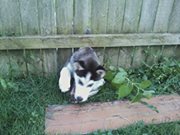
Many dogs go missing from their own home while an owner is on vacation and a pet sitter is looking after the family home and pets. The pet sitter may be a seasoned professional who is charging a fee, or she may be a family member or friend who is doing a favor for the owner.
Owners may presume that their normally friendly, obedient dog will act exactly the same way with the pet sitter as he does with them. This is a recipe for disaster that we see play out time and time again. Whether the pet sitter is a stranger or not, the dog will be in a heightened state of awareness with the change in schedule. Somebody new is coming into the house, perhaps through a different door, perhaps struggling with a key, and their beloved owner is nowhere to be seen. Even though it may seem a minor change, it may still be very stressful for the dog. Countless times we have heard the story about the normally friendly dog who slipped out on the pet sitter or who was let outside to go potty without a leash and bolted in fear.
How can you prevent this from happening? Set your dog and your pet sitter up for success. Here are a couple of simple tips to prevent your dog from going missing:
- Under no circumstances allow the pet sitter to take your dog out without a properly fitted collar or harness and leash. Visible id tags should be securely attached to the collar. Double leashing (one to the collar and one to the harness) is even better.
- Add an extra layer of security. Ask the pet sitter to enter the house through a door that comes through the garage or a fenced yard. That way if your dog does slip out, he will still be in an enclosed area.
- Check your fences and gates before you leave. Ask your pet sitter to make sure that the gates are always securely latched. Also ask her to monitor the condition of the fence regularly.
Prepare a “Just in Case” Packet
Make sure your dog’s microchip is up to date. Leave clear full-body photos of your dog, his vet records, his licensing information and his microchip brand and number in an easily accessible spot for the pet sitter in case they have to quickly file a missing dog report. Make sure the pet sitter understands that they have the authority to act quickly on your behalf. They should not be embarrassed or afraid to ask for help. Time is of the essence and getting that report filed quickly is really important. We have heard too many horror stories about pet sitters who delayed filing a report because they were embarrassed that they had lost the dog and they didn’t want their reputation to suffer.
Your pet is relying on YOU to keep him safe until you are home from vacation. Check references and credentials for pet sitters carefully. Make phone calls and ask tough questions. Don’t ask a family member, friend or teenager to pet sit if you think they won’t take the responsibility seriously. Make sure you take every precaution when using a pet sitter. Nobody wants to see a vacation end in tragedy. But if your dog does go missing, we are here to help!
Create your free lost dog flyers and social media links from our partner, Pet FBI at www.petfbi.org. One of our volunteers will post it to the Lost Dogs Illinois Facebook Page.





